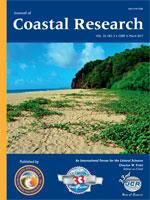Bento, L.; Masuda, L.S.M.; Peixoto, R.B., and Enrich-Prast, A., 2017. Regulation in the metabolism and community structure of a tropical salt flat after rainfall.
Tropical salt flats typically lack a water column for most of the year, which means that rainfall is probably one of the major factors that regulate benthic microalgae and metabolism in areas subjected to periodic drought. Therefore, the goal of this study was to evaluate the effects of rainfall on the ecological function and community structure of a tropical mangrove salt flat area. This study showed that the highest primary production and respiration fluxes were recorded on the last day of sampling when it rained (−7.6 and 4.7 mmol C-CO2 m−2 h−1, respectively). Net primary production increased significantly compared with the dry period that preceded the rain event. The results also suggested that community structure was regulated by rainfall. After the rain event, abundance increased by one order of magnitude, but the diversity and evenness indices decreased. These results demonstrate that rain does have strong regulatory effects on the ecological function and structure of tropical salt flats.





